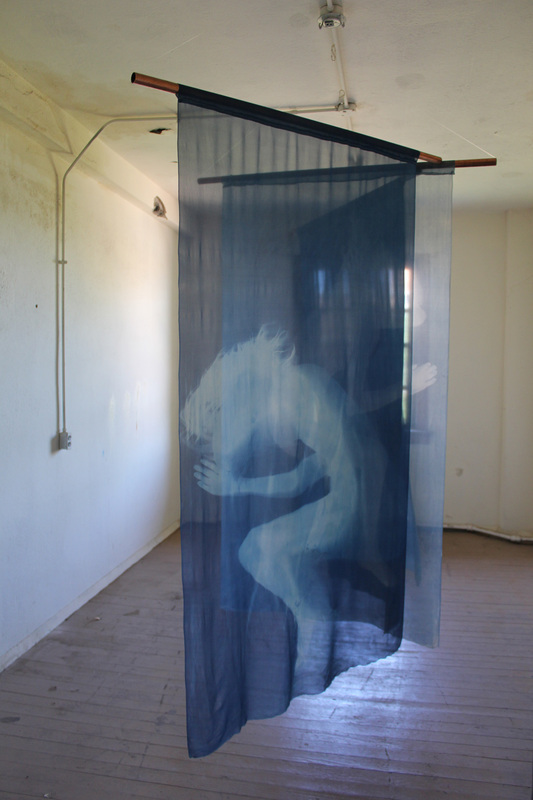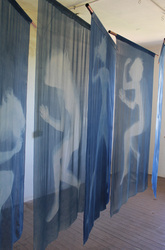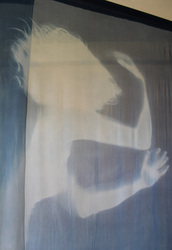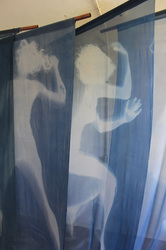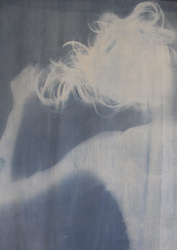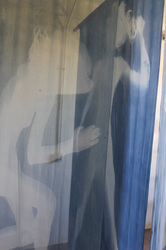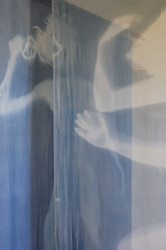Traces, Silk and Cyanotype Chemicals, Dimensions Vary
Carlynn Forst utilizes cyanotypes, one of the earliest forms of photography, to create a series of prints that weave together ancient history, memory and the connections forged between diverse and distant peoples. The process captures the ephemeral interplay between light, shadow, and the movement of wind onto silk fabric. Prints result from an object’s presence on a chemically treated surface where the chemicals permanently bond with light and turn blue, while unexposed areas remain white.
The finished product results in a vivid “blueprint,” here, the subject is the artist's own body. Far from being the mathematically precise schematic of a master architect, the indistinct edges of her form are more truthful admissions of her rough and ever changing nature. The fixing of light’s contact with silk represents an ancient human impulse to become intimate with the divine. The psychological impact of the color itself emphasizes longing, since blue creates an illusion of distance due to its association with atmospheric perspective. The blue of the sky, the haze on the horizon, the blue of the ocean all point to what is far away and thus lends itself to religious symbolism of distant gods. The central element of Tengriism, one of the world’s oldest religions, involves the worship of the sky god, Tengri. The name literally translates as “blue”. The silk too echoes these themes as a material with its own very long history covering and uniting many miles of land and sea. Its production began in China and was traded with the greater Eurasian continent across the Silk Road.
The materials and process used in “Traces” implicates the possibility of a direct bond with the divine, of earthly body and heavenly light merging together. Simultaneously, the prints honor the lack of precision, solidity and permanence of such a union. It bears the mark of all memories, fuzzy around the edges, constantly shifting in response to the changing winds of reality, and eventually destined to disintegrate. But such a loss too is temporary - that union with the divine can always be rediscovered.
The finished product results in a vivid “blueprint,” here, the subject is the artist's own body. Far from being the mathematically precise schematic of a master architect, the indistinct edges of her form are more truthful admissions of her rough and ever changing nature. The fixing of light’s contact with silk represents an ancient human impulse to become intimate with the divine. The psychological impact of the color itself emphasizes longing, since blue creates an illusion of distance due to its association with atmospheric perspective. The blue of the sky, the haze on the horizon, the blue of the ocean all point to what is far away and thus lends itself to religious symbolism of distant gods. The central element of Tengriism, one of the world’s oldest religions, involves the worship of the sky god, Tengri. The name literally translates as “blue”. The silk too echoes these themes as a material with its own very long history covering and uniting many miles of land and sea. Its production began in China and was traded with the greater Eurasian continent across the Silk Road.
The materials and process used in “Traces” implicates the possibility of a direct bond with the divine, of earthly body and heavenly light merging together. Simultaneously, the prints honor the lack of precision, solidity and permanence of such a union. It bears the mark of all memories, fuzzy around the edges, constantly shifting in response to the changing winds of reality, and eventually destined to disintegrate. But such a loss too is temporary - that union with the divine can always be rediscovered.
